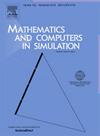On the computational modeling of the behavior of a three-dimensional Brusselator system using a localized meshless method
IF 4.4
2区 数学
Q1 COMPUTER SCIENCE, INTERDISCIPLINARY APPLICATIONS
引用次数: 0
Abstract
Nonlinear coupled reaction–diffusion equations form an important class of partial differential equations (PDEs) as they are central to the study of certain processes arising in chemical kinetics and biochemical reactions. The analytical solutions of such equations are difficult to establish and often require certain simplified assumptions, which demand for alternative solution procedures. Finite difference, finite element and spectral schemes are well-established methods to tackle such equations, yet they have the challenging issues of mesh generation, underlying integral evaluations, ill-conditioned dense system matrices, and are often restricted by domain geometry. This article presents an efficient and simple localized meshless approximation scheme to analyze the solution behavior of a three-dimensional reaction–diffusion system. The proposed scheme produces sparse (collocation) differentiation matrices for discretization of spatial differential operators which alleviates the problem of ill-conditioned and dense collocation matrices. The scheme is a truly meshless, background integration-free scheme and is equally effective for solving problems over non-rectangular domains with scattered data points. The convergence, stability, and positivity properties of the proposed scheme are theoretically established and numerically verified on some benchmark problems. The outcomes verify the reliability, accuracy, and simplicity of the proposed scheme in higher dimensions when compared to the available results in the literature.
用局部无网格法对三维Brusselator系统的行为进行计算建模
非线性耦合反应扩散方程是一类重要的偏微分方程(PDEs),因为它们是研究化学动力学和生化反应中某些过程的核心。这类方程的解析解很难建立,往往需要某些简化的假设,这就要求采用替代的解程序。有限差分、有限元和谱格式是解决此类方程的成熟方法,但它们存在网格生成、潜在积分评估、病态密集系统矩阵等具有挑战性的问题,并且经常受到域几何的限制。本文提出了一种高效、简单的局部无网格近似格式,用于分析三维反应扩散系统的解行为。该方案产生稀疏(配置)微分矩阵用于空间微分算子的离散化,缓解了配置矩阵的病态和密集问题。该方案是一种真正的无网格、无背景积分的方案,对于解决具有分散数据点的非矩形域上的问题同样有效。理论证明了该方案的收敛性、稳定性和正性,并在一些基准问题上进行了数值验证。与文献中已有的结果相比,结果验证了该方案在更高维度上的可靠性、准确性和简洁性。
本文章由计算机程序翻译,如有差异,请以英文原文为准。
求助全文
约1分钟内获得全文
求助全文
来源期刊

Mathematics and Computers in Simulation
数学-计算机:跨学科应用
CiteScore
8.90
自引率
4.30%
发文量
335
审稿时长
54 days
期刊介绍:
The aim of the journal is to provide an international forum for the dissemination of up-to-date information in the fields of the mathematics and computers, in particular (but not exclusively) as they apply to the dynamics of systems, their simulation and scientific computation in general. Published material ranges from short, concise research papers to more general tutorial articles.
Mathematics and Computers in Simulation, published monthly, is the official organ of IMACS, the International Association for Mathematics and Computers in Simulation (Formerly AICA). This Association, founded in 1955 and legally incorporated in 1956 is a member of FIACC (the Five International Associations Coordinating Committee), together with IFIP, IFAV, IFORS and IMEKO.
Topics covered by the journal include mathematical tools in:
•The foundations of systems modelling
•Numerical analysis and the development of algorithms for simulation
They also include considerations about computer hardware for simulation and about special software and compilers.
The journal also publishes articles concerned with specific applications of modelling and simulation in science and engineering, with relevant applied mathematics, the general philosophy of systems simulation, and their impact on disciplinary and interdisciplinary research.
The journal includes a Book Review section -- and a "News on IMACS" section that contains a Calendar of future Conferences/Events and other information about the Association.
 求助内容:
求助内容: 应助结果提醒方式:
应助结果提醒方式:


